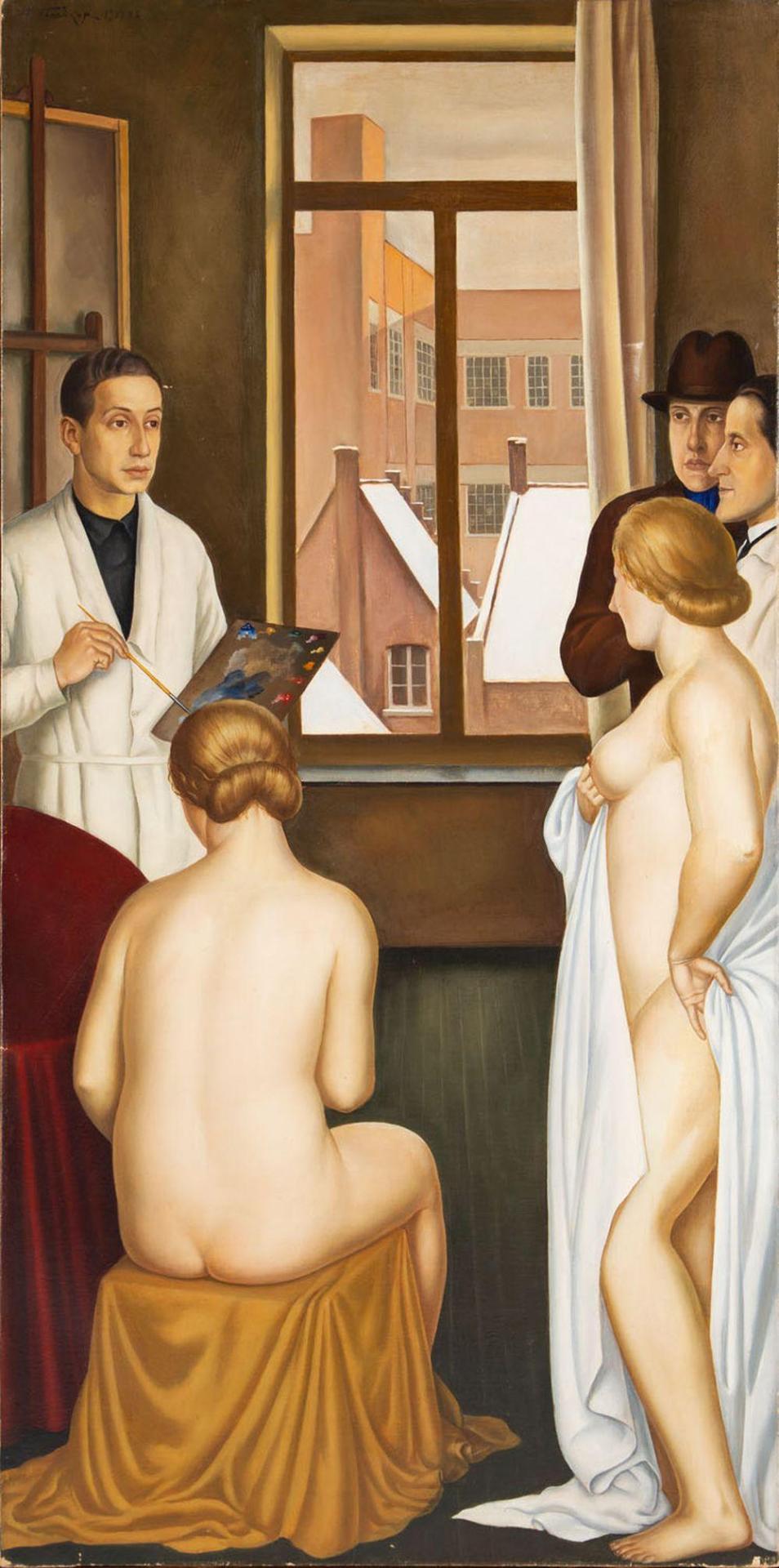Self-Portraits Throughout the Ages. I strive to share interesting, unusual, and evocative self-portraits.(A side-blog of Pagan Sphinx Art Blog)
Don't wanna be here? Send us removal request.
Text

Anna Zinkeisen (British, 1901-1976) • Self-Portrait • c. 1944 • National Portrait Gallery, London
Anna Zinkeisen's sister Doris was also a painter. I posted her self portrait here.
#art#art history#painting#self portrait#oil painting#anna zinkeisen#doris inkeisen#sister artists#woman artist#british artist#female artist#artist as subject#the canvas mirror art blog#art herstory#20th century british art#national portrait gallery london
16 notes
·
View notes
Text

Umberto Boccioni (Italian, 1882-1916) • Self-Portrait • 1905
Boccioni an influential Italian painter and sculptor. He helped shape the revolutionary aesthetic of the Futurism movement as one of its principal figures. Despite his short life, his approach to the dynamism of form and the deconstruction of solid mass guided artists long after his death.[4] His works are held by many public art museums, and in 1988 the Metropolitan Museum of Art in New York City organized a major retrospective of 100 pieces. – Wikipedia

Boccioni's Dynamism of a Cyclist (1913) is perhaps his best known work and an example of futurism which strived to depict speed, modern methods of transport, and the depiction of the dynamic sensation of movement.
#art#self portrait#art history#painting#umberto boccioni#futurism#dynamism#early 20th century european modernism#20th century art#modernism#artist as subject#the canvas mirror art blog#artwork#oil painting#art blogs on tumblr#art lovers on tumblr#italian artist
24 notes
·
View notes
Text


Jean Honoré Fragonard (French, 1732−1806) • Self-Portrait • 1770 • Villa Fragonard, Grasse, France
#art#art history#painting#self portrait#oil painting#artist as subject#the canvas mirror art blog#art blogs on tumblr#art lovers on tumblr#artwork#jean honoré fragonard#french artist#19th century european art#rococo artist
18 notes
·
View notes
Text

Leonid Frechkop (Russian, 1897 - 1982) • Dans l'atelier (Self-portrait in the artist's studio) • 1927-28
#art#art history#painting#oil painting#leonid frechkop#early 20th century Russian art#self portrait#self portrait in a group#artist as subject#the canvas mirror art blog#art nudes#artist studio#art blogs on tumblr#art lovers on tumblr
13 notes
·
View notes
Text

Aleksandr Yakovlevich Golovin (Russian, 1863 – 1930) • Self-Portrait • 1919
#art#art history#painting#self portrait#aleksandr golovin#early 20th century russian art#oil painting#artist as subject#the canvas mirror art blog#art blogs on tumblr#art lovers on tumblr#artwork
22 notes
·
View notes
Text

Marie-Geneviève Bouliard (French, 1762–1825) • Self-Portrait • 1792 • Norton Simon Museum, Pasadena, California, U.S.
Marie-Geneviève Bouliar was one of a small number of women artists to receive public recognition in 18th-century France. The daughter of a tailor, she learned to paint under the guidance of the acclaimed portraitist Joseph-Siffred Duplessis. Early in her career, Bouliar was among the first generation of women to exhibit their work in the Parisian Salon, and she won the Prix d’Encouragement (Encouragement Prize). Soon after, the government provided her with a rent-free studio in the Louvre, indicating official recognition of her talent.
#art#art history#painting#self portrait#woman artist#marie-geneviève bouliard#female artist#french artist#portrait painter#artist as subject#artwork#art blogs on tumblr#the canvas mirror art blog#oil painting#art lovers on tumblr#women in art history
41 notes
·
View notes
Text


Archibald John Motley, Jr. (American, 1891 – 1981) • Self-Portrait • 1920
#art#art history#painting#self portrait#oil painting#the canvas mirror art blog#artist as subject#artwork#archibald motley#art blogs on tumblr#art lovers on tumblr#early 20th century american art#jazz age artist#african american artist#american artist#american modernism
23 notes
·
View notes
Text


Doris Zinkeisen (British/Scottish, 1898 -1991) • Self-Portrait • c. 1929 • National Gallery, London
#art#art history#painting#self portrait#doris zinkeisen#british artist#woman artist#scottish artist#female artist#artist as subject#the canvas mirror art blog#oil painting#art blogs on tumblr#art lovers on tumblr#artwork
48 notes
·
View notes
Text

Bernard Boutet de Monvel (French, 1881–1949) • Self-Portrait, Place Vendôme • 1932
#art#art history#painting#self portrait#oil painting#bernard boutet#french artist#20th century european art#artist as subject#art blogs on tumblr#the canvas mirror art blog#art lovers on tumblr
127 notes
·
View notes
Text

Constance Mayer (French, 1774–1821) ) • Self-Portrait • c. 1801 • Bibliothèque Marmottan, Académie des beaux-arts
#art#art history#painting#oil painting#self portrait#constance mayer#woman artist#artist as subject#french artist#portraitist#the canvas mirror art blog#art blogs on tumblr#early 19th century european art#artwork
27 notes
·
View notes
Text


Annibale Carracci (Italian, 1560 - 1609) • Self-Portrait on an Easel • 1604 • Hermitage Museum, Saint Petersburg, Russia
#art#art history#painting#oil painting#self portrait#annibale carracci#italian artist#baroque master#17th century european art#artist as subject#the canvas mirror art blog#art blogs on tumblr#art lovers on tumblr#artwork
37 notes
·
View notes
Text

Polly Thayer Starr (American, 1904 - 2006) • Self-Portrait – The Algerian Tunic • 1927
#art#art history#painting#self portrait#polly thayer starr#female artist#woman artist#american artist#artist as subject#oil painting#the canvas mirror art blog#art blogs on tumblr#art lovers on tumblr#boston school#early 20th century american art#artwork
33 notes
·
View notes
Text

Maeve Gilmore (British/English, 1917 - 1983) • Self-Portrait with Charcoal • c. 1958 • National Gallery, London
#art#art history#painting#oil painting#self portrait#maeve gilmore#woman artist#british artist#20th century british art#artist as subject#british modernism#the canvas mirror art blog#female artist
7 notes
·
View notes
Text


Claude Monet (French, 1840 - 1926) • Self-Portrait with a Beret • 1886
#art#self portrait#art history#painting#oil painting#claude monet#french artist#impressionism#19th century european art#artist as subject#the canvas mirror art blog#art blogs on tumblr#art lovers on tumblr#artwork
49 notes
·
View notes
Text

Maeve Gilmore (British/English, 1917 - 1983) • Self-Portrait • 1972
#art#art history#painting#self portrait#maeve gilmore#british/english artist#female artist#woman artist#oil painting#artist as subject#the canvas mirror art blog#art blogs on tumblr#art lovers on tumblr#artwork
59 notes
·
View notes
Text

David Jagger (British/English, 1891 - 1958) • Self-Portrait • 1928
Intense or unsettling?
#art#art history#self portrait#painting#oil painting#realism#david jagger#british/english artist#the canvas mirror art blog#artist as subject#art blogs on tumblr#art lovers on tumblr#artwork#portraitist
107 notes
·
View notes
Text

Marc Chagall (Russian, 1887 - 1985) • Self-Portrait with Seven Digits • 1913
In Self Portrait with Seven Fingers, Chagall refers to the colorful Yiddish folk expression Mit alle zibn finger, (with all seven fingers,) meaning "working as fast and as hard as possible".
#art#art history#painting#oil painting#self portrait#marc chagall#unique self portraits#cubism#art lovers on tumblr#artist as subject#artwork#the canvas mirror art blog#art blogs on tumblr#russian artist#jewish artist
56 notes
·
View notes